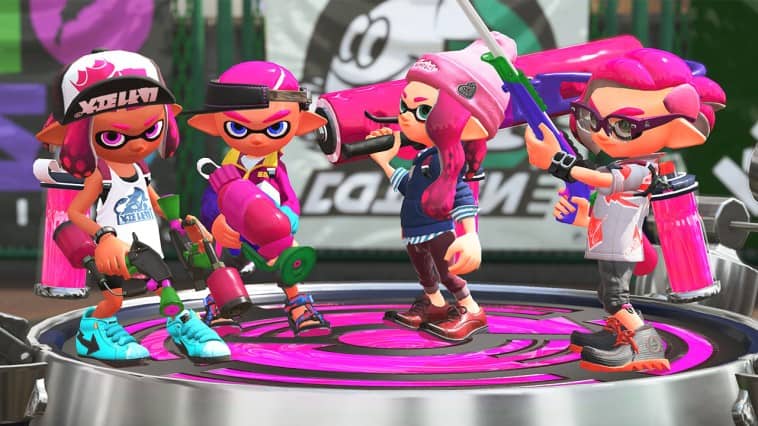Video Gamer is reader-supported. When you buy through links on our site, we may earn an affiliate commission. Prices subject to change. Learn more
There’s something inescapably joyous about the Splatoon series (for it is a series now, of course), so that even if you’re consistently splatted by the same player over and over again you don’t take it personally, and even if you spend a whole morning never winning a match you don’t rage quit. Who cares? We’re just a bunch of crazy kids trying to cover everything in paint! I’ll get you next time, you scallywag! Hahaha!
Having said that, you can sometimes feel the frustration radiating from the level 14 player who ended up on a team of level threes, all of whom either a) don’t know what they’re doing or b) don’t have access to the more useful gear yet. Then there are the times when the matchmaking puts all the higher level players on one team, and all the lower level players on the other, so you never really stood a chance. Your bright green paint falls to the tide of enemy purple from the off, the paint still having a beautiful, almost solid look to it where it lands, and you end the match with a paltry 28.3% floor coverage to your name. It’s barely enough to look the baddies in the eye, let alone beat them.
/https://oimg.videogamer.com/images/fd69/a741f193-954a-4927-ba42-4d2a8becc373_NSwitch_Splatoon2_03_mediaplayer_large.jpg)
Splatoon 2 doesn’t really start to become fun until you pass approximately level four, at which point you can start tooling up with some of the cooler weapons, like the Dualies, the rapid-fire guns you wield with one in each hand, or the Slosher, which is literally just a bucket of paint. As you level up you unlock access to better versions of said weapons, and better gear. But Splatoon 2 has made subtle changes to the weapons that can really affect the flow of battle, even if they don’t seem like a big deal on paper.
Weapons, including some new ones, now come with special moves they didn’t have in the original Splatoon, so if you’re using the Dualies you can perform a dodge roll, if you’ve got the Roller you can jump and attack for a vertical splash of paint, and the Splat Charger (which is essentially a sniper rifle) now keeps its charge for a short distance of ink swimming. It’s an addition which has made the battles more dynamic — surprisingly so — and intelligent use of these abilities is the difference between an okay player and a very good one. If you’re the former, this difference can seem huge.
/https://oimg.videogamer.com/images/6720/40946d53-eaf5-47fe-bf0a-22398e7c9a46_Splatoon2_scrn_SalmonRun09.jpg)
Weapons aren’t the only addition to Splatoon 2, of course. There’s also the new horde co-op mode Salmon Run, where you and a team of four must shoot Salmonids (vaguely unhappy looking fish that slime their way onto shore in a distinctly slug-like way, leaving trails of green paint as they do) and collect the specified number of golden eggs from destroying Boss Salmonids. These range from a giant metal eel contraption being driven by a tiny Salmonid at the tail, to a flying Salmonid shooting paint missiles from packs on either side of its body, to a sniper on top of a precarious tower of cooking pans.
The hectic and at times desperate co-op in Salmon Run is one of the most enjoyable parts of Splatoon 2 — provided you manage to find a team. You can play in local co-op whenever you like, but Salmon Run is only sporadically available for online matchmaking, and if you don’t match up with a full team you’re thrown into the match alone, with no option to back out and a randomised weapon. Fighting advancing hordes with only a bucket of paint and no ability to res yourself means a short, disappointing round and penalties to your wages.
/https://oimg.videogamer.com/images/be5c/3228c250-af88-4a31-8acc-57888ab7b02f_Switch_Splatoon2_scrn_HeroMode_00.jpg)
Splatoon 2 also provides a single-player, where you take on the mantle of a secret agent guided by Marie, one of the Squid Sisters from the original. It isn’t exactly breaking new ground after the first Splatoon, But it’s a Nintendo platformer, so, you know, it’s got varied levels, and it gradually layers in new skills and ideas without you noticing, until suddenly you realise that it’s actually grown quite difficult. There are six hub areas, each functioning as a mini platforming level in itself, and each with several levels and a boss fight you have to best before you move on. The bosses in particular, like in Salmon Run, smack of Nintendo enemy design: technically totally family friendly, but specifically weird enough that they’ll haunt the nightmares of some child, somewhere. The first one is a stack of toasters, or possibly ovens, with a tentacle sticking from the top, and from which angry loaves of bread extend.
It’s strange and well made, and it’ll tide you over a few hours, but the multiplayer is still the star. Though there were some connection problems over our time with the game, Splatoon 2 isn’t unstable, and you can enjoy a few rounds uninterrupted. The continual circulation of maps keeps everyone on their toes, occurring often enough to be interesting, but not so frequent that it becomes annoying. Despite imperfections, Splatoon 2 improves on the original, and although the motion controls aren’t an easy way to play, the Switch is a good home for it. Prepare to eat paint, punk.
/https://oimg.videogamer.com/images/b962/4391e242-1e6d-4207-85e8-f794624fa81d_NSwitch_Splatoon2_05_mediaplayer_large.jpg)
Developer: Nintendo
Publisher: Nintendo
Available on: Nintendo Switch
Release date: July 21 2017
